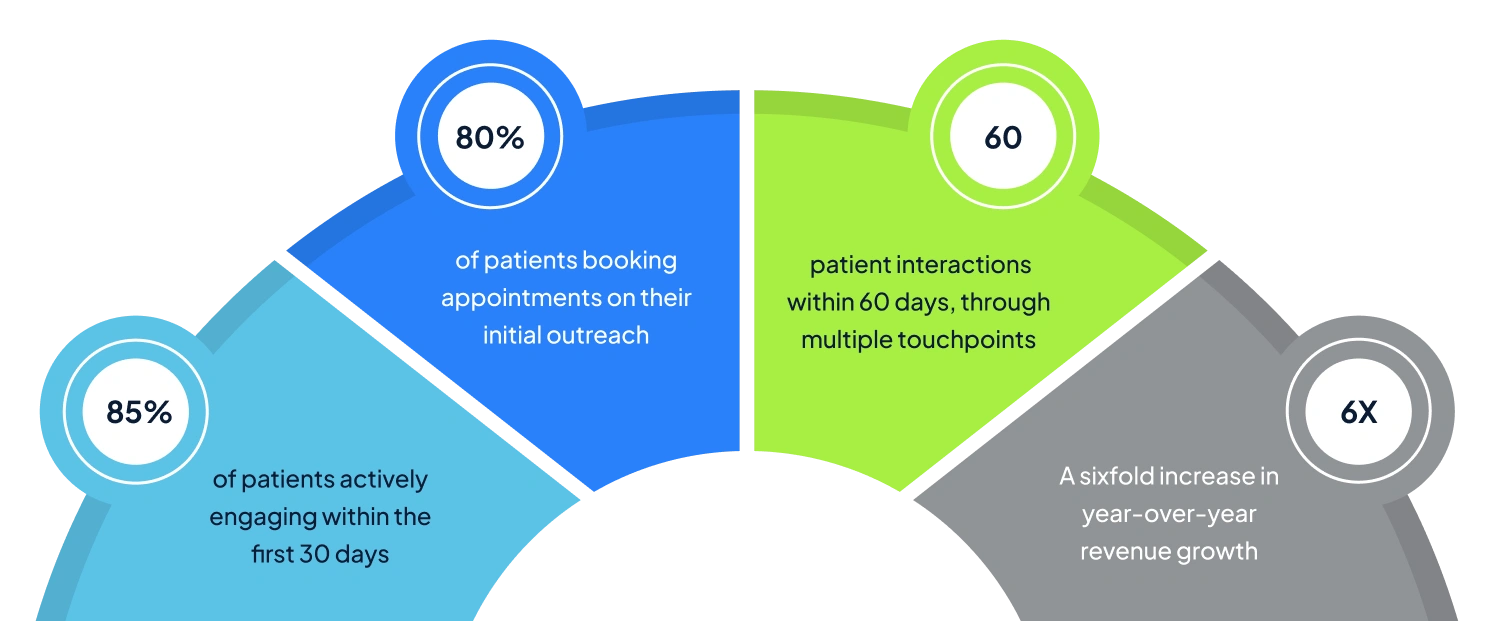The Best Patient Engagement Solutions in Illinois
Transform Your Patient Engagement with VALiNTRY360’s Digital Solutions

Strong patient engagement is the foundation of exceptional healthcare delivery, ensuring better patient outcomes and greater satisfaction. With the right approach, patient engagement fosters consistent treatment adherence, fewer readmissions, improved chronic care, and healthier communities overall.
For healthcare organizations across Illinois from the urban centers of Chicago to the rural areas of southern Illinois adopting digital patient engagement methods is more than beneficial; it’s a vital necessity. The state’s healthcare systems must serve diverse populations, including aging adults, multicultural urban dwellers, and underserved rural patients.
Fortunately, cloud-driven digital tools now exist to overcome the unique challenges faced by Illinois-based care providers.
The Patient Engagement Challenge
Healthcare providers in Florida encounter multiple challenges in ensuring effective, personalized patient care:
Health data is often dispersed across multiple systems, limiting access to a complete view of a patient’s history. This lack of integration hinders the ability to deliver coordinated, informed care.
Solution:
Unified Patient Profiles
Develop 360-degree profiles of each patient for personalized care. And streamlining the whole process from enrollment to exit.
Consolidate data from various sources, including EHRs, wearables, and patient surveys, into one easily accessible profile.
Give care teams the ability to access full patient histories, including social determinants of health.
- Encourage collaborative care through secure data sharing among authorized healthcare professionals.
Inefficient patient outreach leads to missed appointments and low compliance with treatment plans. Traditional communication methods are often ineffective, especially within Illinois’s diverse communities.
Solution:
Streamlined Communication
Adopt multi-channel communication strategies to enhance appointment attendance and treatment compliance.
Leverage automated SMS reminders, email notifications, and patient portal messages to engage patients.
Implement patient-preferred communication methods to reach individuals via their chosen channels.
Facilitate two-way communication for quick responses to patient queries and easy appointment rescheduling.
Lengthy wait times and decreased staff productivity arise from manual processes and outdated systems. This is especially problematic in high-demand healthcare environments like those of Illinois’s urban centers.
Solution:
Automated Workflows
Enhance operational efficiency through AI-powered task management and resource optimization.
- Automate repetitive tasks like appointment scheduling and follow-up notifications.
Implement smart triage systems to prioritize patient care effectively.
Leverage predictive analytics to anticipate patient flow and adjust staffing accordingly.
Balancing data security with HIPAA compliance while delivering smooth patient interactions is a challenge, especially as digital health tools become more prevalent.
Solution:
Secure Data Management
Ensure full HIPAA compliance and safeguard data with a secure digital infrastructure.
Apply role-based access controls to protect confidential patient information.
Utilize advanced security tools to enable strong encryption and data monitoring.
Maintain comprehensive audit trails for tracking data access and modifications.
Disconnected healthcare information systems create incomplete patient records, complicating comprehensive and timely care. Providers frequently struggle with limited access to accurate, real-time patient information across facilities and departments.
Solution:
Population Health Management
Lower healthcare costs and reduce disparities with a centralized, always-accessible source of truth.
Create patient portals featuring unified profiles to facilitate personalized communication and streamline care plan execution.
Deploy automated, multi-channel outreach to improve appointment attendance and boost adherence to treatment plans.
Utilize analytics to pinpoint high-risk patient groups, track health metrics in real time, and predict potential issues for timely, proactive care.
-
Fragmented Patient Data
-
Communication Gaps
-
Operational Inefficiencies
-
Regulatory Compliance
-
Limited Access / Fragmented Care
Health data is often dispersed across multiple systems, limiting access to a complete view of a patient’s history. This lack of integration hinders the ability to deliver coordinated, informed care.
Solution: Unified Patient Profiles
Develop 360-degree profiles of each patient for personalized care. And streamlining the whole process from enrollment to exit.
Consolidate data from various sources, including EHRs, wearables, and patient surveys, into one easily accessible profile.
Give care teams the ability to access full patient histories, including social determinants of health.
Encourage collaborative care through secure data sharing among authorized healthcare professionals.
Inefficient patient outreach leads to missed appointments and low compliance with treatment plans. Traditional communication methods are often ineffective, especially within Illinois’s diverse communities.
Solution: Streamlined Communication
Adopt multi-channel communication strategies to enhance appointment attendance and treatment compliance.
Leverage automated SMS reminders, email notifications, and patient portal messages to engage patients.
Implement patient-preferred communication methods to reach individuals via their chosen channels.
Facilitate two-way communication for quick responses to patient queries and easy appointment rescheduling.
Lengthy wait times and decreased staff productivity arise from manual processes and outdated systems. This is especially problematic in high-demand healthcare environments like those of Illinois’s urban centers.
Solution: Automated Workflows
Enhance operational efficiency through AI-powered task management and resource optimization.
Automate repetitive tasks like appointment scheduling and follow-up notifications.
Implement smart triage systems to prioritize patient care effectively.
Leverage predictive analytics to anticipate patient flow and adjust staffing accordingly.
Balancing data security with HIPAA compliance while delivering smooth patient interactions is a challenge, especially as digital health tools become more prevalent.
Solution: Secure Data Management
Ensure full HIPAA compliance and safeguard data with a secure digital infrastructure.
Apply role-based access controls to protect confidential patient information.
Utilize advanced security tools to enable strong encryption and data monitoring.
Maintain comprehensive audit trails for tracking data access and modifications.
Solution: Population Health Management
Lower healthcare costs and reduce disparities with a centralized, always-accessible source of truth.
Create patient portals featuring unified profiles to facilitate personalized communication and streamline care plan execution.
Deploy automated, multi-channel outreach to improve appointment attendance and boost adherence to treatment plans.
Utilize analytics to pinpoint high-risk patient groups, track health metrics in real time, and predict potential issues for timely, proactive care.
VALiNTRY360’s Patient Engagement Solutions
Harness the power of digital, cloud-based technology to create a seamless, unified patient engagement platform:
-
Patient Management
-
Telehealth Integration
-
Appointment Management
-
Billing and Payment Management
-
Real-Time Insights
- Monitor complete patient history, including medical records, appointments, and past interactions.
- Deliver personalized care recommendations based on each patient’s unique profile and risk factors.
Implement care plans with automated task delegation and real-time progress tracking.

Integrate video conferencing for virtual consultations, removing barriers to accessing care.
- Utilize remote patient monitoring to track vital signs and symptoms in real time.
- Facilitate secure messaging between patients and care teams to provide continuous support.

- Simplify scheduling with intelligent calendar management and optimized resource allocation.
- Minimize no-shows with automated reminders and convenient rescheduling options.
- Use waitlist management to efficiently fill last-minute cancellations.

Streamline financial operations with automated billing systems.
Offer clear cost estimates and flexible payment solutions for patients.
Seamlessly integrate insurance verification and claims processing to enhance the financial experience.

Leverage predictive modeling to identify at-risk patients for timely interventions.
- Optimize resource distribution based on patient needs and past usage patterns.
- Monitor and enhance key metrics like patient satisfaction, readmission rates, and adherence to care plans.
- Create custom reports and dashboards for real-time, data-driven decision-making across the organization.

Monitor complete patient history, including medical records, appointments, and past interactions.
Deliver personalized care recommendations based on each patient’s unique profile and risk factors.
Implement care plans with automated task delegation and real-time progress tracking.

- Integrate video conferencing for virtual consultations, removing barriers to accessing care.
- Utilize remote patient monitoring to track vital signs and symptoms in real time.
- Facilitate secure messaging between patients and care teams to provide continuous support.

- Simplify scheduling with intelligent calendar management and optimized resource allocation.
- Minimize no-shows with automated reminders and convenient rescheduling options.
- Use waitlist management to efficiently fill last-minute cancellations.

- Streamline financial operations with automated billing systems.
- Offer clear cost estimates and flexible payment solutions for patients.
- Seamlessly integrate insurance verification and claims processing to enhance the financial experience.

- Leverage predictive modeling to identify at-risk patients for timely interventions.
- Optimize resource distribution based on patient needs and past usage patterns.
- Monitor and enhance key metrics like patient satisfaction, readmission rates, and adherence to care plans.

What You Can Expect with VALiNTRY360’s Patient Engagement Solutions


Why Choose VALiNTRY360’s Patient Engagement Experts?
We specialize in cloud-based, digital solutions designed to enhance patient engagement, with a deep understanding of Illinois’s healthcare needs.
Our clients experience substantial improvements in care coordination, with clear, measurable benefits to both health outcomes and operational efficiency.
We customize our implementations to suit the unique needs of each provider, whether it's a small clinic or a large hospital system.
Ready to Upgrade Your Patient Engagement?
Whether you serve Chicago’s urban core or a rural clinic in central Illinois, legacy systems should no longer limit your potential. With VALiNTRY360, you’ll be empowered to:
Increase patient
satisfaction
Elevate health
outcomes
Maximize operational
efficiency
Ensure regulatory
compliance
Drive financial
growth
Reach out to VALiNTRY360 today for a free consultation and take the first step toward transforming your patient engagement strategy, delivering exceptional care experiences across the Grand Canyon State.
The Best Patient Engagement Solutions in Illinois FAQ By 
Patient engagement is the process of actively involving patients in their healthcare decisions, encouraging them to take part in their treatment plans.
Engaged patients experience better health outcomes, higher satisfaction, improved treatment adherence, and reduced overall healthcare costs.
Key challenges include fragmented patient data, communication barriers, inefficiencies in operations, and compliance with regulatory requirements.
Digital solutions help by creating unified patient profiles, simplifying communication, automating tasks, and ensuring secure management of patient data.
Population health management takes a proactive approach to improving health outcomes for groups of people, often targeting specific regions or patient demographics.
Implementing a PHM strategy leads to improved health outcomes, lower healthcare costs, enhanced care coordination, and more efficient resource management.
Data analytics help identify high-risk patients, forecast potential health issues, and provide valuable insights for targeted interventions and optimized resource allocation.
Social determinants of health refer to non-medical factors like housing, education, and income that affect health outcomes. They are key in PHM for addressing underlying causes of health disparities.
Telehealth supports virtual consultations, remote monitoring, and secure messaging, improving access to care and offering continuous support for patients.
VALiNTRY360 provides solutions for patient management, telehealth integration, appointment management, and billing to enhance patient engagement and improve overall care experiences.
Providers can leverage secure platforms that offer role-based access controls and create comprehensive audit trails for tracking all data access and modifications.
Success can be gauged by monitoring key metrics like patient satisfaction scores, appointment attendance rates, treatment compliance, and improvements in overall health outcomes.
AI supports predictive analytics, automates patient communication, streamlines triage processes, and offers personalized care recommendations based on patient data.
Chronic disease management focuses on continuous engagement and support for self-management, while acute care emphasizes short-term treatment adherence and timely follow-up.
Approaches include simplifying technology interfaces, offering multiple communication channels, involving family members, and providing in-person support when necessary.
By utilizing data-driven insights, providers can automate routine tasks while customizing meaningful interactions based on each patient’s unique needs and preferences.
Failing to implement effective population health management can lead to greater health disparities, escalating healthcare costs, suboptimal patient outcomes, and missed opportunities for preventive care and early detection.
Patient portals offer convenient access to medical records, appointment scheduling, secure messaging with providers, and tools to help manage care plans and medications effectively.
Providers can boost adoption by offering hands-on training and support, showcasing the advantages of digital tools, ensuring user-friendly design, and seamlessly integrating them into routine healthcare practices.


